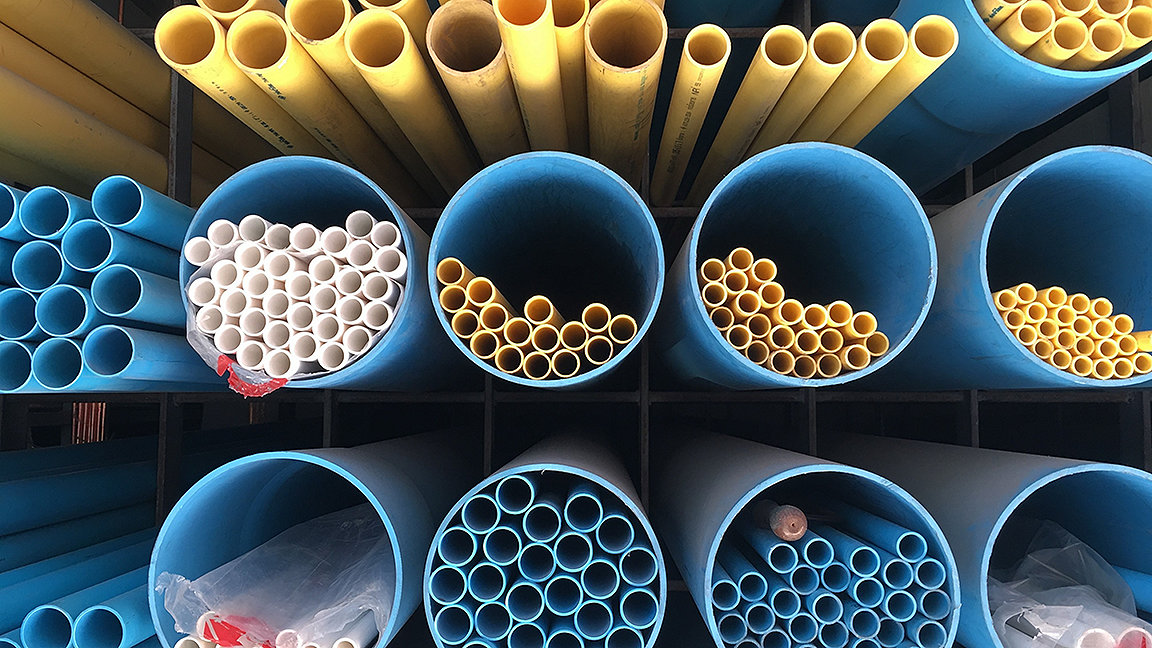
The transition to sustainable construction will involve fundamental changes in the way buildings are designed, manufactured, built and operated. As society pushes up against established planetary boundaries, professionals working in the built environment need to identify how to change our practice.
Although the clear impact our work has on climate change and biodiversity are emerging, we need to better understand the link between the built environment and human health – particularly the pollution caused by manufactured chemicals, so-called novel entities.
A key aspect of doing so is understanding the properties of the materials we build our world from, especially ubiquitous plastics. At present, while exact safety thresholds for use are fiercely debated, the evidence shows a clear need for precaution and further research.
Versatility of plastics leads to widespread use
The modern world is built from plastics that, thanks to their unrivalled diversity, versatility and inexpensiveness, have enabled important technological advances and numerous other societal benefits. Plastics are also key materials in modern buildings, enabling low-cost housing, healthcare, disaster resilience and high-performance Passivhaus architecture.
The construction industry consumes 20% of all plastics and 70% of all polyvinyl chloride (PVC) produced globally each year. Exponentially greater amounts are being produced and used, with 8.3bn tonnes of virgin plastics produced worldwide between 1950 and 2017 and global output predicted to double by 2050.
Plastics are used in a vast range of building components, such as seals, windows and doors, roofing, internal and external finishes, paints, panels, varnishes, stains, pipes, guttering, cables, floor coverings, membranes, formwork, supporting structures, building skins and insulation. However, their benefits come at a growing cost to the environment and public health.
Regulation and research focus on waste
As our industrial capitalist society starts coming to terms with the huge amounts of post-consumer plastic waste it generates and the unacceptable environmental degradation this causes, governments have begun to regulate the production, use and disposal of plastics. Examples include the US Break Free From Plastic Pollution Act of 2021, and the European Strategy for Plastics in a Circular Economy.
Recent academic and professional focus has centred on the reuse of plastic waste streams to create new, sustainable construction products as part of a circular economy. However, industrial plastic materials are not designed for reuse, and attempts to create a circular economy using plastic waste streams themselves start to pose risks to human health and well-being.
Construction plastics pose particular problems
Although the environmental impacts of plastics are well known by building professionals and their clients, the effect of construction plastics on public health is less well understood. Plastic polymers themselves are not a health concern, except for carcinogenic PVC; however basic plastic polymers are useless in construction applications.
The unique properties of construction plastics are a result of the thousands of additives, fillers and reinforcing materials used in their manufacture. Many of these are untested, and of the small percentage that have been scientifically peer-reviewed many have been found to be toxic, with the potential to cause serious harm to human health and development at manufacture, installation, use or disposal.
A meta-analysis in 2021 identified more than 2,000 additives used in construction industry plastics, of which 25% were classified as EU substances of concern due to their persistence, bioaccumulation or toxicity. Similarly, a further study found up to 88% of chemicals in everyday plastic products, including common construction finishes, leach out into the environment during use.
Furthermore, the use of plant-based bioplastics or recycled plastics makes little difference to toxicity as the same additives are required to achieve the material performance.
'Although the environmental impacts of plastics are well known, the effect of construction plastics on public health is less well understood'
Academics advise risks need further study
The current debate pits the plastic industry's assertion that the dose makes the poison – that is, any chemical is toxic in a high enough dose – against the precautionary principle advocated by leading researchers who, while able to demonstrate specific health risks from particular chemicals, note the need for significant further study and funding. This research is needed to understand the true risks of bioaccumulation of toxins in the body over time, and the impact of multiple exposures to chemical mixtures in actual scenarios.
Additives can make up to 7% of the mass of plastic, with some of the worst offenders being:
- phthalate plasticizers, proven endocrine disruptors – a class of toxins that pose risks to reproductive health, immune response, and embryonic development
- flame retardants, such as polybrominated diphenyl ethers and perfluorochemicals used in furniture textiles and linked to neurotoxicity in children
- per- and polyfluoroalkyl substances used to make plastic building products resistant to heat, oil stains and grease; these are known as forever chemicals, given their indefinite persistence in the environment, and are linked to adverse health impacts such as fertility issues, obesity and cancers
- antimicrobial compounds used extensively in surface finishes for healthcare facilities, which are linked to increasing microbial resistance and contamination of wastewater.
Growing academic evidence connects the additives in plastics and other compounds formed during their manufacture to an ever-growing range of human health issues, affecting humans at all stages of our development.
Two key routes of exposure for humans to the toxins in plastics are inhalation and through the skin, typically in the form of microplastics and volatile organic compounds released from plastic products in internal environments. The latter can cause significant indoor air pollution.
The third major route of exposure is in the combustion of plastics, both intentional and accidental, which releases highly carcinogenic dioxins. In the case of PVC, it also creates hydrochloric acid fumes, and with polyisocyanurate (PIR) insulation hydrogen cyanide gas.
Following the tragic 2017 Grenfell Tower fire in London, studies demonstrated the PIR insulation installed on the facade increased the toxicity of the smoke 15 times and the lethality of the fire 40-fold compared with non-combustible insulation.
Short-term concerns stymy long-term view
The design and construction industry has focused for so long on aesthetics, efficiency and material performance, that it has avoided asking many questions about the relationship between the built environment and health – perhaps because it is concerned about accepting liability, given the toxic legacies of materials such as lead or asbestos.
Growing evidence points to a future public health crisis as all of us who live, work and play in our built environment are exposed daily to unnecessary chemical cocktails from plastics.
At the same time, the construction industry remains a key contributor to climate change and creates an estimated third of the world's waste, with emerging responses to this issue focusing on the production of new construction products from post-consumer plastic waste as part of a circular economy.
Recent research highlights that products made from plastic waste concentrate chemicals and toxins from various sources potentially amplifying adverse health impacts.
Our short-term focus on dealing with vast amounts of plastic waste may inadvertently contribute to long-term health crises, if plastic materials continue to be used, but are not designed for reuse or future incorporation into buildings, in accordance with as yet undeveloped technical standards.
'Growing evidence points to a future public health crisis as all of us are exposed daily to unnecessary chemical cocktails from plastics'
Professions can take lead on mitigating impacts
So how can the health impacts of construction plastics be mitigated? While the necessary research and regulations are only now emerging, professionals in all roles can raise awareness and show leadership on the issue by advocating for precautionary action in their own projects.
Building surveyors can:
- identify excessive use of plastics in buildings, in those areas likely to expose people to unnecessary risks, especially either in-utero or young children
- when advising on the repair and maintenance of buildings, recommend a range of alternatives to plastic products framed in terms of both cost and environmental and health impacts
- develop lifecycle cost models that factor in future impacts on human health, which is especially important for projects in the healthcare sector.
In turn, project managers and lead consultants can:
- educate and influence clients to set appropriate standards for projects in line with their environmental, social and governance (ESG) goals, such as BREEAM, WELL or LEED; these standards encourage good-quality internal environments through ventilation and the reduction of indoor air pollution through the use of non-petrochemical materials
- form design teams around lead consultants with appropriate knowledge of this subject
- prepare design team briefs and tender specifications that link clients' ESG goals to building design and specification, and support these teams in preparing appropriate designs.
Designers and specifiers can meanwhile:
- avoid plastic products where possible, and instead use natural, non-hybrid or easily reusable materials
- avoid products on emerging lists such as the EU substances of concern or the Perkins and Will precautionary lists
- avoid products that claim to have antimicrobial finishes or self-cleaning properties
- avoid unencapsulated recycled plastic materials
- avoid plastic paints and varnishes
- explore product-as-a-service solutions, whereby products are rented from manufacturers rather than purchased outright; this gives manufacturers an incentive to use durable, healthy, quality materials that will last a lifetime
- use good materials and consider how their projects will be dismantled at the end of life, to ensure scarce high-quality materials can be reused rather than downcycled or disposed to landfill
- create a market around high-quality second-hand and remanufactured products and finishes by specifying these where possible; see, for example, RotorDC in Belgium.
Researchers and policymakers can also encourage:
- research into human health impacts of the aggregate effect of actual, simultaneous exposures to chemical mixtures from construction plastics, beyond current research into individual chemicals or single plastic types
- development of standards required to assess safe levels of toxic emissions from current plastics in indoor environments
- comparisons of the material performance of plastics to other materials without toxic additives, and research into non-toxic additives that meet suitable performance criteria and enable safe reuse
- development of technical building standards for the safe reuse of post-consumer recycled plastics in construction, for all applications and budgets.
The benefits of reducing plastic in construction go hand in hand with other benefits, such as improving breathability and indoor air quality, and reducing reliance on global supply chains and petrochemical manufacturers.
Weighing benefits against precautionary principle
A key argument for the use of plastic in construction is the unrivalled performance advantage that plastics have over alternatives, which enable wider benefits such as energy-saving, health and safety, or reducing maintenance. These are said to outweigh their potential for harm. Yet the performance of plastic depends on the use of toxic additives, which have the potential to leach out and enter the human body.
Gaps remain in the evidence around the exact risks to human health, but many studies raise early warnings that should be heeded, following the precautionary principle. Performance needs to be balanced against the growing evidence of plastic's burden on human and environmental health.
The current role of plastics in the built environment is undeniable, and is helping achieve the UN Sustainable Development Goals by enabling low-cost, energy-efficient products for shelter and sanitation. But the scale and projected growth in global construction plastic usage demands greater research into potential public health impacts, to ensure that in addressing current inequities we do not create health burdens for future generations that might otherwise be avoided.
'The performance of plastic depends on the use of toxic additives, which have the potential to leach out and enter the human body'
Tom Smethurst is an architect and project lead at the consultancy Northmores
Contact Tom: Email
Related competencies include: Design and specification, Development/project briefs, Health and safety
RICS champions sustainability across professions
With the built environment estimated to be responsible for around 40% of global carbon emissions, RICS is championing sustainable practices across the built and natural environment. We are also empowering professionals to embed sustainability considerations into the way they work and better measure environmental impacts.


